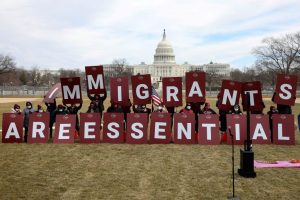Latino vote: Decisive
Which it´s the real value of Hispanic votes? Is Immigration a fundamental issue among Latinos? Why Latinos vote proportionally less than other groups? The new Latino citizens will be part of the half nation that does vote? What will be their impact on the future of democracy in America? To better understand these issues you should read our cover story just few pages ahead.
Meanwhile, it is time to consider that Tuesday, November 8, 2016 can become a historic date for the Latino community in the United States. Some 25 million Hispanics will be eligible to vote and decide one of the most significant presidential elections in the history of this country.
Although it is most likely that around 15 million will ultimately cast their vote, politically speaking it is more relevant that, for about half of them, this will be the first, or mostly second, time that they will participate in a presidential election.
In a political system where the rules of electoral competition are designed to encourage the setting of fifty-fifty, if the trends of the past elections hold true, in 28 states the percentage of the Latino vote will exceed 5 percent of the total cast on the ballots.
Among them, of course, you can count New Mexico (47%), Texas (27%), California (27%), Arizona (20%), New York (18%), Florida (17%), Nevada (16%) or Colorado (14%), where the electoral presence of this community goes well above the national average of almost 11 percent, according to figures of the 2014 presidential election.
Although due the peculiar rules of the American electoral system, the Latino vote in “democratic states” like California or New York, are less decisive than in other “republican states” such as Florida and Texas.
At the end of the day the Latino vote will weigh more in competitive states that may be the difference in the final outcome of the election, like Nevada or maybe New Jersey. Nationally, that can occur in over half the country.
This of course, to the extent that the current trend that at least 75 percent of Latinos continue to vote for the formula of the Democratic Party (which, incidentally is not particularly a rule in states such Texas or Florida) continues.
In the United States there are about 220 million citizens eligible to vote, but in the same path that follows the vast majority of countries worldwide, about half of them won´t even visit the ballots.
In other words, about 110 million people will elect the next President and Congress and therefore will decide the fate of the 11 million undocumented immigrants who have embraced this country as their own (most for over 10 years) and have been waiting for the immigration reform for a quarter of a century.
In this matter, the choice could not be clearer: immigration reform to regularize these people, or their expulsion as promise by Trump and his Republican clones.
Being true that for Latino voters immigration is not the only issue that matters. Like the rest of the population the status of the economy will affect the way that they will vote. But the fact is that for millions of families the issue of legal migration is a reality that exists in the flesh, and therefore is a priority that generates a major mobilization among this community.
From the above, it should be no surprise that more than 80 percent of Latinos manifest against a possible candidacy like Trump’s according to recent polls.
Democratic exhaustion
In the global context in which social disenchantment with the traditional way in which policy is made is the sign of our times, and America is not, of course, the exception. Therefore, consistent turnout of nearly half of the electorate, and the emergence and showcasing of anti-system proposals by candidates such as the entrepreneur Donald Trump, is of particular importance to the annual arrival in the electoral stage of a million young Latinos who reach the age to vote (18 years) since the beginning of this decade and for the next 20.
The great paradox of the next election is the same formula that has helped to attract media spotlight and political support to people like Trump –the demonization and harassment against the immigrant community, particularly Mexican- origin, could well become the major catalyst to move to the highest voter turnout in the history of Hispanic America.
The demographic factor thereof: Latinos are significantly younger than the rest of the population — serves to understand why voter turnout levels have traditionally been lower than the national average. The same argument, incidentally, helps to explain the lower rates of schooling and economic power of this community.
However, right now massively Hispanics are entering the electoral market. A rate of two potential new voters every 30 seconds, are the fastest growing country in the political market.
Of course the challenge is whether, in the context of growing apathy and disillusionment in politics, half Latino voting or nonvoting be integrated.
The (new) democratic traditions
Particularly true in the case of Mexican immigrants (two thirds) or the Central and South America immigrants, the lack of a longstanding democratic culture is a factor that has also inhibited the political participation of Latinos.
In stark contrast to other groups –as the Jewish — community where levels of turnout reach two thirds of its community, there is the perception that Latinos are not interested in politics, perhaps with the exception of Puerto Rican and Cuban communities (who received no major obstacles to the right to vote).
It is true that migrants who arrived from Mexico in the second half of the last century came from a dominant-party political system (the perfect dictatorship), where the pyramid of power seemed eternal, favoring authoritarianism and corruption. But it is also true that since 2000, the country is experiencing a real democratic opening process, with political participation levels slightly above the international average.
Therefore, assuming that Latinos will remain outside the policy does not seem a safe bet. Especially in the framework of initiatives such as the recently launched White House to encourage immigrants who are able to obtain citizenship (about 8 million) initiate the process and eventually vote.
In contrast to traditional advertising, according to which in the country of Mickey Mouse, democracy is perfect, the very recent history of American politics has shown clear signs of exhaustion of the traditional model. The 2000 election (Al Gore versus Bush) in which the winner of the popular vote did not reach the White House despite many irregularities demonstrated throughout the process, is just one example in this regard.
In fact, the very emergence of “populist” proposals such as the phenomenon called Trump is further evidence of the many cracks in the current political system.
Therefore, the arrival in this decade and the next of about 20 million new voters is one of the most important opportunities for the restructuring of the entire democratic system, still recognized as the least bad of all the mechanisms for the distribution of political power in a country.
One of the great challenges to the electorate ahead of the next presidential election is that the decision at the polls will not be a referendum on President Barack Obama, for the significant progress and achievements of his administration. Most likely will be a decision based on the personalities of the candidates selected by the two major parties.
Instead and beyond who finally are candidates (not Hillary Clinton or Donald Trump) the electoral process will be marked by trade-offs usually not central in a presidential election, but they are now on the agenda of priorities and seem fairly clear:
In foreign policy, the choice may be between sophisticated electorate and related leadership to the international community call (Clinton type) or a supposedly strong rhetoric but subsistence, a local equivalent of Vladimir Putin (Trump type).
Domestically, unless Republicans succeed to present themselves as the party of economic equity (which now seems impossible), it is feasible that an issue affecting just over 3 percent of the population (illegal immigration) will become a major electoral banner.
In that scenario, the big electoral battle of 2016 could end up being, at least for the Hispanic voters, including those who raise the banner of racism, discrimination, and inclusive positions, a battle for the new face of America, a country that in a short time a third of its population will be Latino.










